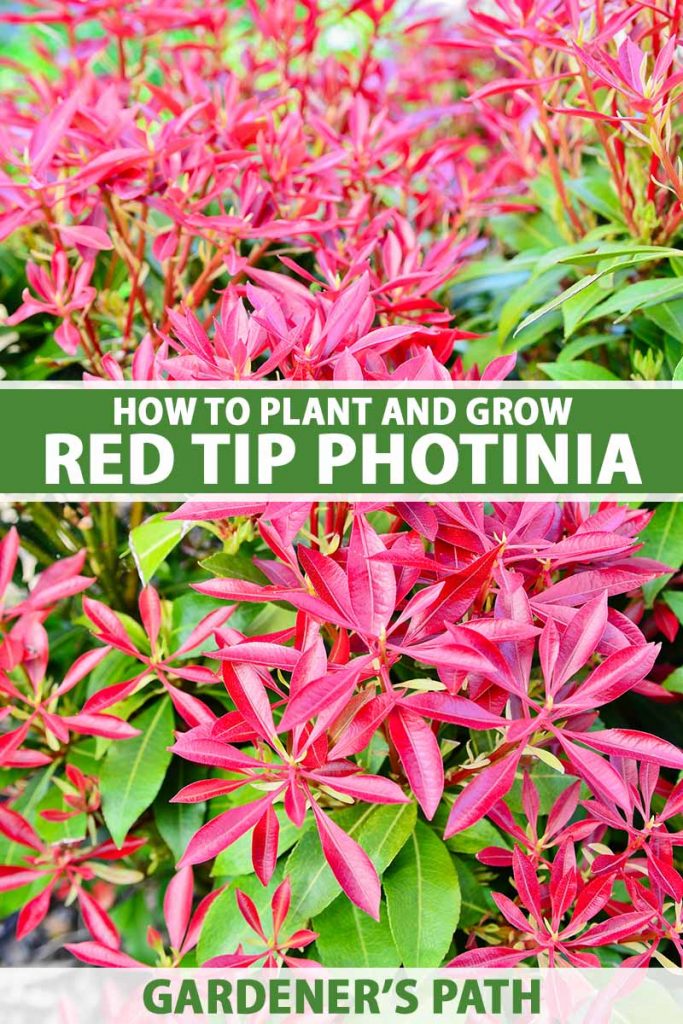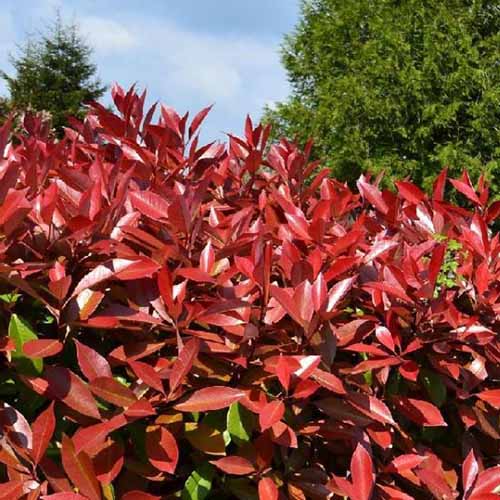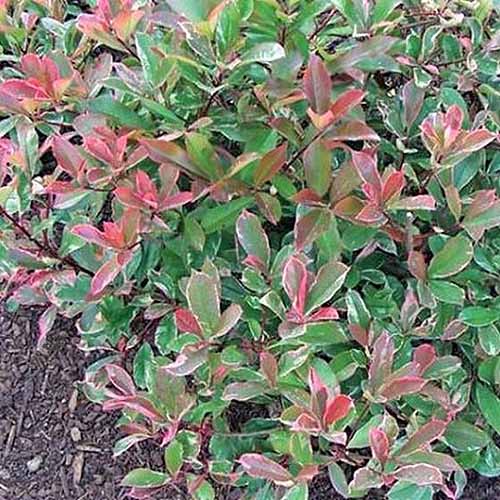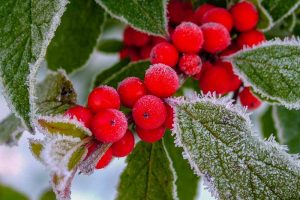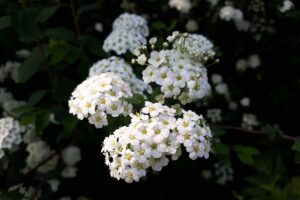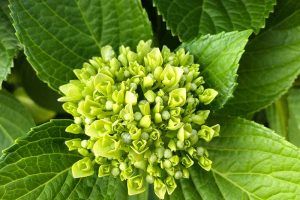Photinia x fraseri
Red tip photinia is an easy to grow ornamental shrub that’s prized for its dense red and green foliage.
Also known as Fraser (or Fraser’s) photinia or red top photinia, its leaves start off red, then turn a deep green over a period of several weeks. It is prized as an ornamental hedge shrub in southern regions of the United States.
Hardy in Zones 7-9, it is a vigorous grower that can tolerate just about any kind of soil as long as it is well-draining.

We link to vendors to help you find relevant products. If you buy from one of our links, we may earn a commission.
Frequently chosen by urban landscapers, this large shrub is planted widely and is a popular choice for gardens in those areas. Although its toxic berries aren’t safe for human consumption, they are beautiful to look at and birds love them.
Ready to learn more? Here’s what’s ahead:
What You’ll Learn
Easily shaped into a small specimen tree, this shrub is often used as a privacy screen or hedge. No matter how you choose to grow it, you’ll love the beauty and elegance it brings to your garden.
What Is Red Tip Photinia?
Red tip photinia is a large shrub frequently used for hedging. There are at least 50 named species in the Photinia genus.
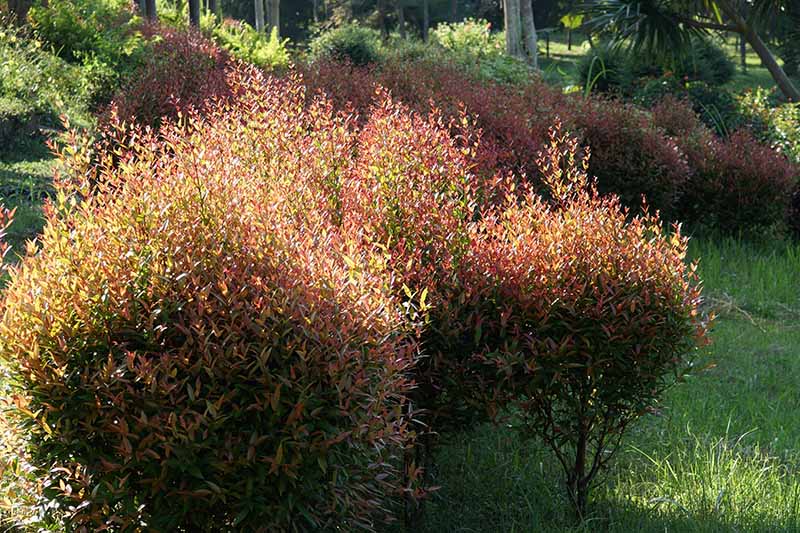
And there’s some debate among botanists over whether certain plants in the Heteromeles, Aronia, and Stranvaesia genera should be considered part of this genus instead. Regardless, all are members of the rose family, Rosaceae.
Red tip photinia grows to around 10-15 feet tall on average and roughly five to eight feet wide. However, this can vary depending on the cultivar and age of the plant. It grows quickly, adapting rapidly to just about any kind of soil.
A naturally occurring hybrid of Japanese (P. glabra) and Chinese photinia (P. serratifolia), Japanese photinia produces smaller flowers than red tip, and Chinese photinia grows quite a bit larger than P. glabra or P. x fraseri.
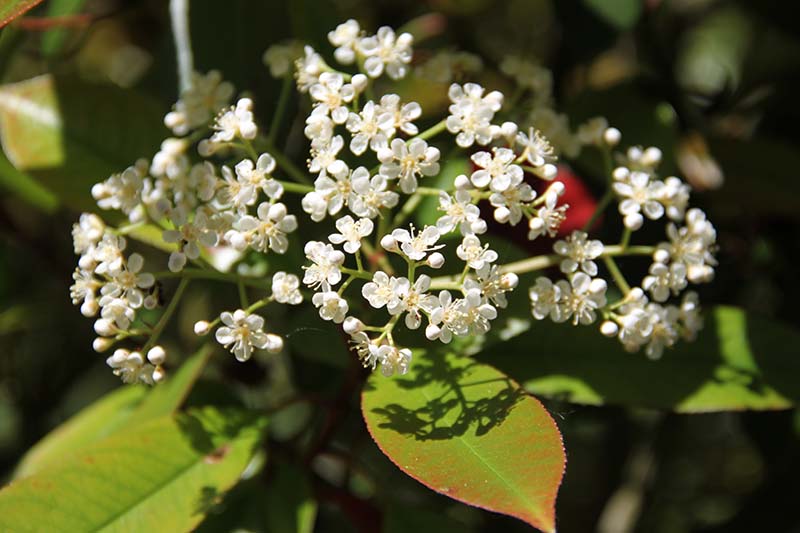
Red tip photinia produces clusters of tiny white flowers in mid-spring. These flowers are beautiful to look at, but they are known for their unpleasant smell.
In the summer, inedible red fruits appear. These ornamental fruits, though toxic to us, are beloved by birds.
But what this plant is really known for is its evergreen foliage that is bright red when it first begins to grow.
Cultivation and History
This plant’s genus name is derived from the Greek word “photeinos,” which means shiny. This is in reference to its beautiful glossy leaves, something shared by all plants in the genus.
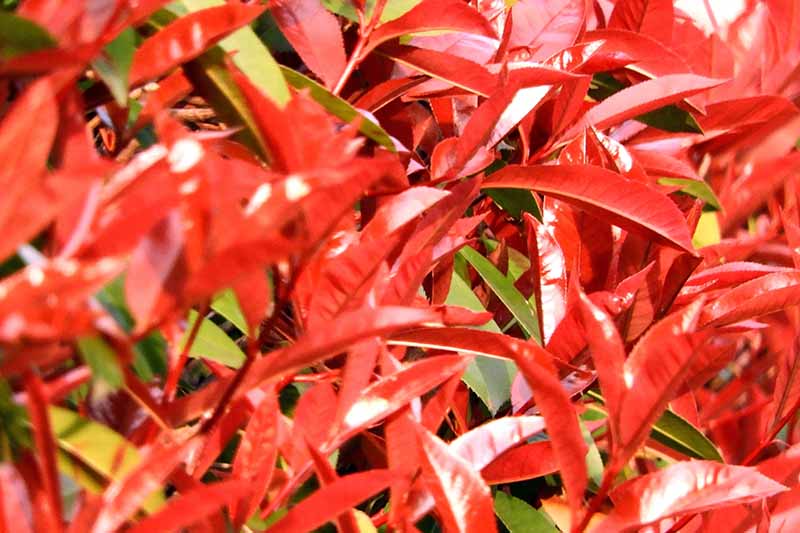
The red-tip variety’s parent plants are native to warm, temperate areas of Asia, including parts of Japan, Thailand, and India. P. x fraseri is now grown all around the world as an ornamental.
According to Gerald Klingaman, a retired horticulturist at the University of Arkansas, it was first named and documented in 1940 by Ollie W. Fraser, nurseryman from Birmingham, Alabama.
Propagation
Because it is a hybrid plant and won’t grow true to seed, the best way to propagate red tip photinia is via stem cuttings.
This will provide you with a clone of the original plant, with identical characteristics. You can also purchase a transplant from a nursery.
From Cuttings
To propagate a new plant from a cutting, you will need to save a piece that has at least three leaf nodes.
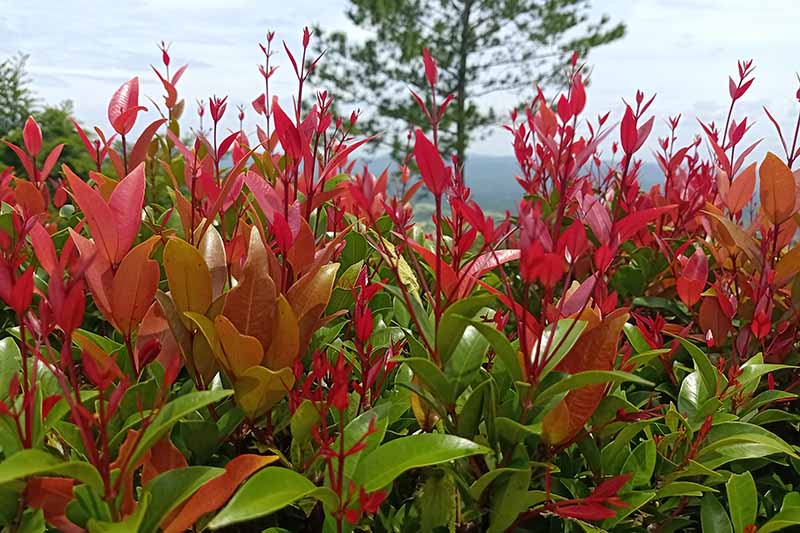
While there are several ways you can propagate photinia from cuttings, it is easiest to do this by taking semi-hardwood cuttings in midsummer, ideally from stems that have just started to mature.
Healthy cuttings may be saved when you do your pruning, if you like.
You should take a six- to eight-inch cutting from an area of new growth, generally at a point where the stem has just started to harden and mature. Remove the leaves from the lower half of the cutting.
Fill a pot with a mixture of vermiculite and perlite, and water thoroughly. A container that’s around six inches in diameter is perfect for planting one or two cuttings.
Before planting, dip the cut end into rooting hormone powder, and tap it to remove any excess before you place the cutting at a depth of approximately two to four inches.
If you plant multiple cuttings, make sure they do not touch.
Let it root indoors or in a protected location that receives indirect sunlight. Keep the porous medium moist at all times, to help the roots develop.
It can take as little as a month or as long as 20 weeks to produce new growth. Once this new growth appears, you can check whether your cuttings have rooted by gently tugging on the stem.
If you feel resistance, your new plant is ready to be transplanted, as described below.
Your rooted photinia cuttings can be transplanted in the late summer or early spring in a location that is partially shaded or sunny and well-draining.
Transplanting
You can also purchase a transplant from a nursery. Whether you’re planting a photinia that you grew from a cutting yourself or planting a potted specimen that you purchased, there are several recommendations you should follow.
In a location that receives full sun to partial shade, dig a hole twice as deep and twice as wide as your potted plant (usually at least 12 inches deep and wide).
Backfill halfway, adding some organic matter such as compost or leaf mold. Then, remove the shrub from its container, place it in the hole, and backfill with soil.
Make sure the top of the soil of the potted plant is at ground level, adding or removing soil as needed. Continue backfilling and water well after you have finished.
If you are growing multiple plants to create a hedge, you should space them about five feet apart. In shady locations or when a hedge form is not desired, more space is preferred to promote good airflow and help prevent fungal infections.
How to Grow
The best place to grow red tip photinia is in a spot that receives full sunlight to partial shade.
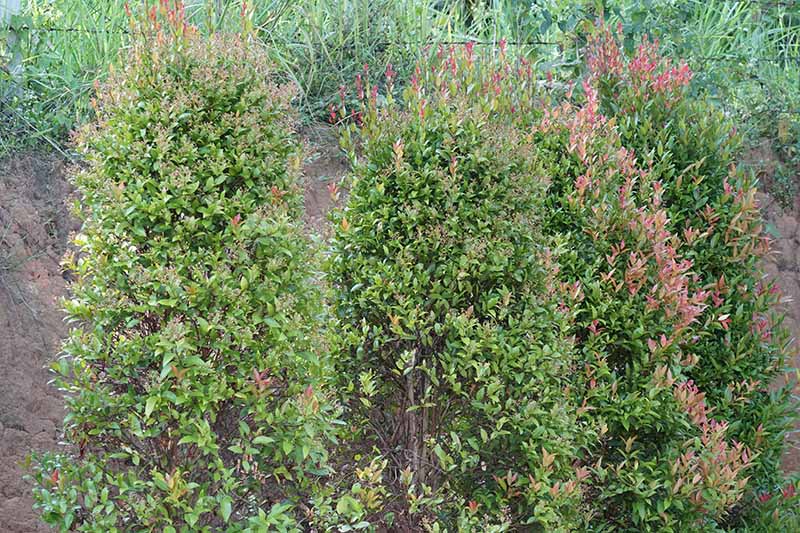
This plant is tolerant of most soil types, but the soil does need to be well-draining. Fertile loam or light soil with a low clay content is best. If your soil is extremely heavy, amend it with some sand before planting.
This plant is tolerant of alkaline soil, and it also handles salt spray and drought with ease, according to North Carolina State Extension’s Plant Toolbox.
While it doesn’t mind dry soil, it does not tolerate waterlogged soil or wet feet.
Mulching can help to retain soil moisture and keep weeds at bay. When you mulch, leave an inch of space between the trunk of the plant and the layer of mulch to prevent rot.
Water deeply at ground level every seven to 10 days in the first two years after planting, more often if there is no rainfall for several weeks.
Once your shrub is established, it will receive enough water from rainfall alone, except in extremely dry, warm conditions. You only need to water when the top two inches of soil are dry.
The best way to fertilize this shrub is by amending the soil prior to planting with a well-balanced organic fertilizer or compost.
While you can certainly apply fertilizer later on, be careful about applying too much nitrogen, as photinia is prone to nitrogen stress. This can cause leaves to turn yellow.
When growing red tip photinia as a hedge, you should space your plants roughly five feet apart, providing equal distance from other species of plants as well. This will allow room for its mature size while also minimizing the likelihood of fungal disease.
Growing Tips
- Plant in loamy, well-draining soil
- Space plants at least five feet apart
- Fertilize sparingly
Pruning and Maintenance
Red tip photinia can withstand heavy shearing, which is one of the reasons why it performs well as a hedge or privacy screen.
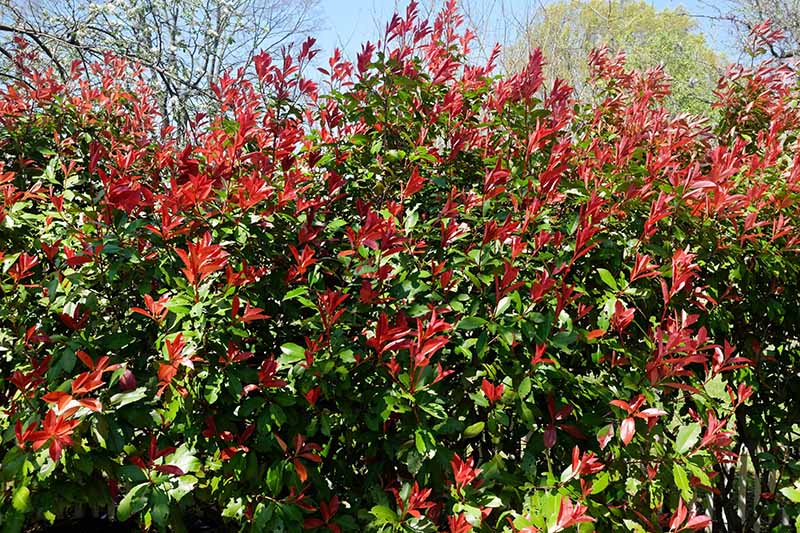
No specific pruning or training is necessary to control its shape as a hedge. It will form a pleasing shape on its own.
By lightly pruning this shrub at its shoot tips every year, you can also encourage the production of new, reddish leaves.
It will halt flower production – not necessarily a bad thing if their aroma bothers you. But keep in mind that this will eliminate ornamental fruit production too.
If your plant is overgrown, you can cut it to the ground in the fall. It should put on new growth in the spring.
If you choose to cultivate this plant in a larger tree form, you can prune back competing shoots around a central leader. This will help shape it into the desired form.
This kind of pruning should be done once or twice a year, ideally in the early spring.
Cultivars to Select
There are several cultivars of red tip photinia for you to choose from.
Red Tip Photinia, P. x fraseri
You can find standard hybrid plants in #5 containers available at Nature Hills Nursery.
Cassini
‘Cassini,’ also known as ‘Pink Marble,’ is a relatively new cultivar of photinia, registered in 2002. It produces leaves that are more pink than red, with white variegated margins.
It can grow up to 14 feet tall and 10 feet wide, making it one of the larger cultivars available.
You can find plants in #2 containers available at Nature Hills Nursery.
Red Robin
‘Red Robin,’ aka Christmas berry, is the most common cultivar. It grows up to 12 feet tall and nearly as wide.
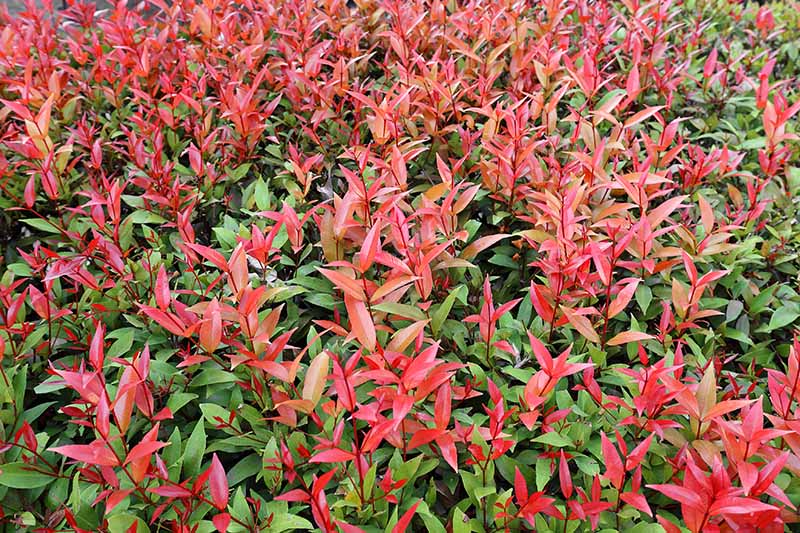
It is easy to trim for use in hedges. And it is one of the few types of photinia that tends to be resistant to leaf spot diseases.
Little Red Robin
Another cultivar you might consider growing is ‘Little Red Robin.’
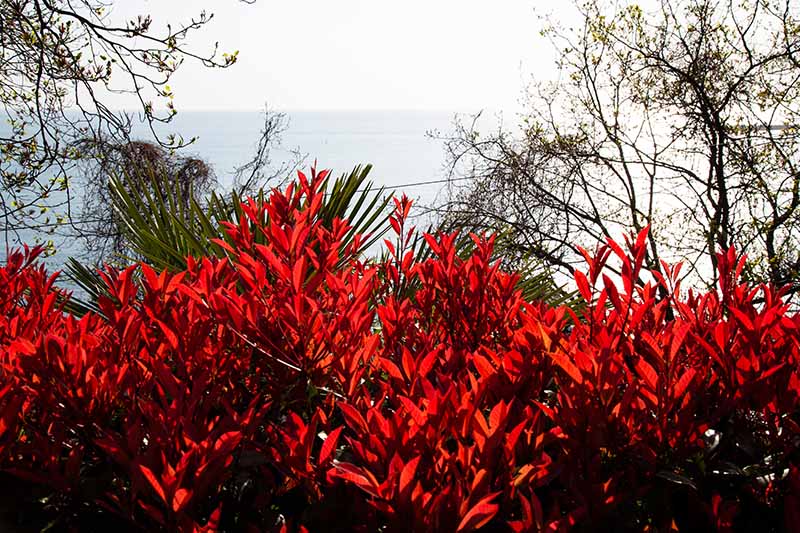
As you might expect from the name, this plant is much smaller than ‘Red Robin’ at maturity, growing to just two to three feet in height and width, but is otherwise quite similar in its disease resistance and appearance.
Managing Pests and Disease
Red tip photinia is, unfortunately, not without its problems when it comes to pests and diseases.
Fungal diseases are prevalent among these shrubs, which is why some landscapers are hesitant to use them as part of a formal hedge planting program.
Fortunately, most animals tend to leave them alone, probably due in part to their malodorous flowers.
Insects
Although fungal diseases remain the most significant cause for concern in most red tip photinia plants, there are a few insect pests you’ll need to keep an eye out for, too.
European Fruit-Tip Moth
The European fruit-tip moth (Grapholita molesta), also known as the oriental fruit moth or the peach moth, is native to China. It attacks all kinds of plants in the rose family, including photinia.
Causing damage primarily to new shoots, in its larval form, this insect can cause fruits and leaves to drop as well. But in most cases you can ignore the presence of this pest on your plants, as it rarely causes severe damage.
Mites
Various types of mites (Tetranychidae spp.) are also common on photinia plants. They cause stippling of the foliage, and leaves will eventually die and fall off.
Fortunately mites are easy to control by applying a basic horticultural oil, but with preventative care, you can usually avoid a large infestation and forego pesticides entirely.
Scale
Scale insects (Coccoidea spp.) are so named because of the shell-like waxy coverings that protect their bodies. They look like little bumps on plants, usually brown in color.
Though they aren’t damaging in small numbers, a large population can cause your plants to experience stunted growth.
You can control these pests with a gentle rubbing alcohol scrub, to remove them from the plants.
They can also be controlled by releasing beneficial insects like ladybugs and lacewings, which eat scale insects at the larval stage, or by using insecticidal soap or neem oil, according to package instructions.
You can find more tips on dealing with scale infestations here.
Disease
Unfortunately, red tip photinia is prone to several diseases. These are the most common:
Fire Blight
Fire blight is a bacterial disease caused by Erwinia amylovora. If your plant is infected, cankers will appear on the wood that leak brown, watery droplets.
Proper watering and adequate air circulation is key to prevent infection.
Open flowers are the most common infection sites, with symptoms spreading rapidly to the wood. You can use a copper spray on flowers in the spring to help control this disease.
Leaf Spot
This fungal disease, caused by Entomosporium maculatum, is a serious problem for red tip photinia, most common during periods of cool, wet weather.
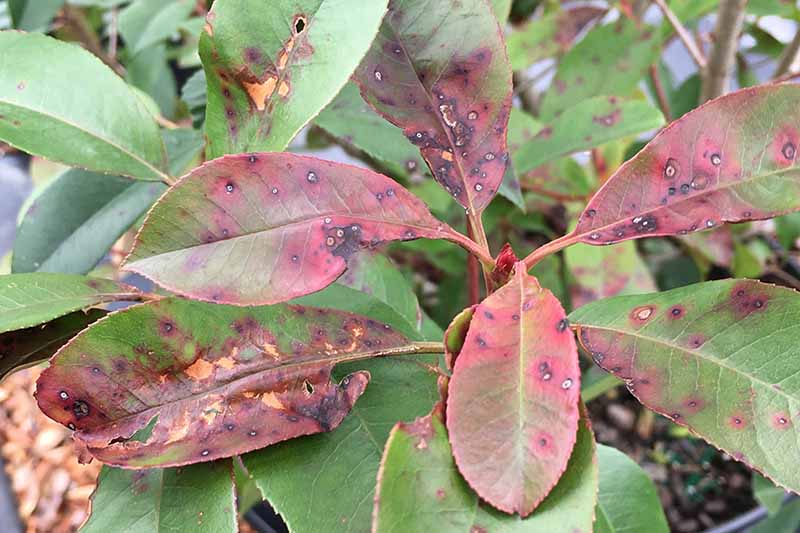
It produces small red spots on new leaves, with heavily diseased foliage exhibiting growing splotches of maroon, evident on leaves as they turn green.
Affected leaves eventually fall from the plant, and this type of infection is easily spread among multiple plants. Spores are spread by both air and water.
Providing excellent circulation and watering at ground level, rather than from above, are the best ways to prevent this disease.
Severe infections may be treated with a fungicide such as thiophanate-methyl or myclobutanil.
Applied as sprays, these fungicides generally offer two to three weeks of protection before they need to be reapplied, though an infection can often be controlled in that timeframe without requiring reapplication.
Affected plant parts should be removed and disposed of to prevent fungal spores from spreading.
Powdery Mildew
Powdery mildew is also common. You can prevent this fungal disease by providing proper spacing. Keep the leaves dry and remove any affected foliage when you see it.
You can learn about how to control powdery mildew in this guide.
Root Rot
Root rot is another common ailment that affects photinia. It can be caused by different species of fungi in the Rhizoctonia and Pythium genera, or by Phytophthora water molds (oomycetes).
Common in poorly drained soils or those that are over-fertilized with nitrogen, you may only notice a problem when it causes the leaves of infected plants to wilt and turn yellow.
Root rot can be difficult to get rid of once it sets in. Purchasing disease-free plants and providing good drainage is essential to help prevent root rot.
Best Uses
This versatile plant can be used in several different ways. Commercial landscapers often select it to grow along highway medians because it can handle the roadway pollution and full sun with ease.
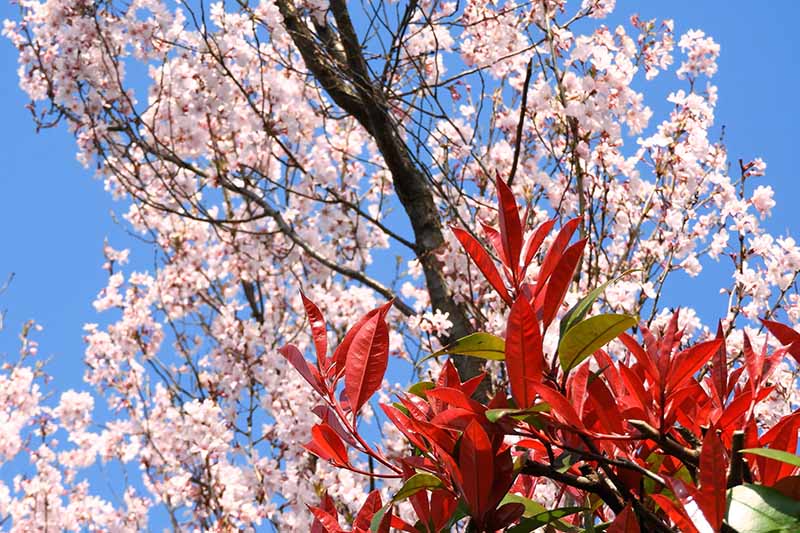
It can also be planted as a specimen tree since it is easy to prune into an upright shape. Many home gardeners prefer to grow it as a tall, dense hedge in formal gardens or for privacy screens.
Quick Reference Growing Guide
| Plant Type: | Woody shrub | Flower / Foliage Color: | White/red and green |
| Native to: | Eastern Asia | Maintenance: | Moderate |
| Hardiness (USDA Zone): | 7-9 | Tolerance: | Poor soil, alkaline soil |
| Bloom Time: | Spring-fall | Soil Type: | Loamy |
| Exposure: | Full sun to part shade | Soil pH: | 6.0-7.5 |
| Spacing: | 5-8 feet | Soil Drainage: | Well-draining |
| Planting Depth: | Same as root ball (transplants) | Attracts: | Bees, birds, and other pollinators |
| Time to Maturity: | 2 years | Uses: | Hedges, specimen trees, privacy plantings |
| Height: | 12-15 feet | Family: | Rosaceae |
| Spread: | 8-10 feet | Genus: | Photinia |
| Water Needs: | Low | Species: | x fraseri |
| Common Pests: | European fruit-tip moths, mites, scale | Common Diseases: | Leaf spot, fire blight, powdery mildew, root rot |
A Compact Shrub with Vibrant Leaves
Red tip photinia is a shrub that offers multi-season interest with its gorgeous red-green leaves, white flowers, and bright red fruit.
Sure, the flowers might be a little stinky – but they sure are pretty to look at! And if the smell bothers you, remember – you can always prune it to curb blossom production.

Provided that you give this plant well-draining soil and plenty of air circulation to prevent fungal problems, you shouldn’t have any trouble growing it.
Have you grown red tip photinia before? Which cultivar calls your garden home? Be sure to let us know if you have any comments or questions.
And for more information about flowering shrubs to grow in your garden, check out these guides next:
- How to Grow Cotoneaster
- How to Grow and Care for Oleander Shrubs
- How to Grow Flowering Quince for Early Spring Color
© Ask the Experts, LLC. ALL RIGHTS RESERVED. See our TOS for more details. Product photos via Nature Hills Nursery. Uncredited photos: Shutterstock. With additional writing and editing by Allison Sidhu and Clare Groom.

